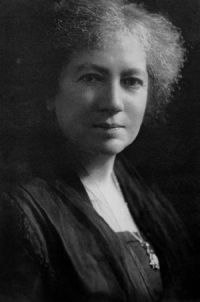 2019 marks 100 years since women were able to be elected as Fellows of the Geological Society, with the first eight elected in May 1919. They came from a diverse range of specialisms, backgrounds and experience – as part of our activities to mark the anniversary, we’re profiling each of them.
2019 marks 100 years since women were able to be elected as Fellows of the Geological Society, with the first eight elected in May 1919. They came from a diverse range of specialisms, backgrounds and experience – as part of our activities to mark the anniversary, we’re profiling each of them.
We know more about some than others – if you have any information you’d like to share with us about our early female Fellows, please get in touch!
Dame Maria Matilda Gordon DBE, 1864 – 1939
 Maria Gordon, nee Ogilvie, was born in Monymusk, Aberdeenshire, and at age 9 entered Merchant Company Schools’ Ladies College in Edinburgh. She showed a profound interest in nature during her childhood, and enjoyed exploring the landscape of the Highlands during holidays.
Maria Gordon, nee Ogilvie, was born in Monymusk, Aberdeenshire, and at age 9 entered Merchant Company Schools’ Ladies College in Edinburgh. She showed a profound interest in nature during her childhood, and enjoyed exploring the landscape of the Highlands during holidays.
An aspiring pianist, at age 18 she travelled to London to study music before deciding on a career in science. She graduated in 1890 with a gold medal from University College London, her BSc specialising in geology, botany and zoology. In 1891 she travelled to Germany, hoping to continue her studies at the University of Berlin. As women were not permitted to enrol in for higher education in Germany she was refused, but at Munich was permitted to carry out research as a private person and to listen to lectures – although she had to sit in a separate room and listen with the doors half open.
In July 1891, the geologist Baron Ferdinand von Richthofen invited Ogilvie on a five week trip to the Dolomites. Having been considering a career in zoology, Ogilvie was so impressed by the landscape of the Dolomites that her interests shifted to geology. For two summers she hiked, climbed and studied various areas, instructing local collectors to carefully record and describe their fossils. Her fieldwork was done without supervision, which she later described as a ‘serious handicap’.
In 1893 she published the results in the article ‘Contributions to the geology of the Wengen and St Cassian Strata in southern Tyrol’ in the Quarterly Journal of the Geological Society. It provided important contributions to the still poorly understood stratigraphic record of these mountains, establishing marker horizons and describing the ecology of various fossil corals associations. Ogilvie alone described 345 species of mollusks and corals of the Wengen and St Cassian Formations – in total today, 1400 species are recognised.
The article gained her the first female Doctor of Science degree in the United Kingdom, from UCL in 1893. Returning to Munich in 1900, she became the first woman to obtain a PhD there, receiving a distinction in the fields of geology, palaeontology and zoology.
Between 1900-14, she continued her explorations in the Dolomites, collecting specimens, writing papers and preparing for a comprehensive study of the geology of the area. Her manuscript was nearly ready for publication in 1914, when she had to leave it and Munich behind on the outbreak of war. When she returned in 1920, the manuscript had disappeared and had to be completely rewritten. It was published in 1927, and given glowing praise in the journal Nature. Recognising the appeal of the subject to non specialists, she also produced two guidebooks for visitors – the first examples of modern geological guidebooks for this region.
Ogilvie was active in politics as a Liberal and supporter of women’s rights. She played an important part in the post-World War 1 negotiations at the Council for the Representation of Women in the League of Nations, and took prominent positions within various national and international women’s societies.
In total, she wrote more than 30 papers based on her research and findings in the South Tyrol, some of which are considered seminal works. Her biographer described her as “probably the most productive woman field geologist of any country in the late 19th and early 20th centuries.”
Read more about our first eight female Fellows:
Sources and further reading:
- Dame Maria Matilda Ogilvie Gordon: Pioneering geologist of the Dolomites (Scientific American)
- The first female Fellows and the status of women in the Geological Society of London. Cynthia V. Burek. Geological Society, London, Special Publications, 317, 373-407, 21 August 2009, https://doi.org/10.1144/SP317.21

Pingback: 100 years of female Fellows: Ethel Woods (nee Skeat) | Geological Society of London blog
Pingback: 100 years of female Fellows: Margaret Crosfield | Geological Society of London blog
Pingback: 100 years of female Fellows – Jane Donald Longstaff | Geological Society of London blog